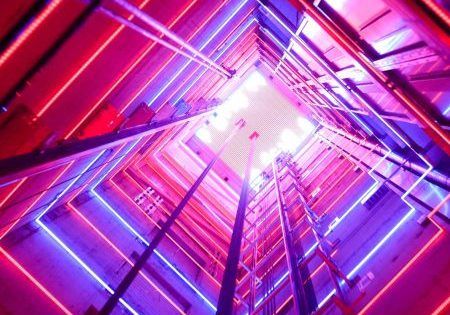by Muharrem Bilge ÇAKIRER
Walls covered in spray paint, damaged doors, torn handles or broken buttons … Vandalism in elevators doesn’t just cause physical damage; it also threatens design integrity and user safety.
Elevator safety is the art of accounting for the unseen. In this article, we address design and technological measures against vandalism in elevator cabins, focusing on how solutions can be developed in a question-and-answer format without compromising aesthetics, and even making aesthetics a protective element.
I must emphasize from the outset that seeing many companies showcase anti-vandal products at the Elevator Istanbul 2025 fair and observing that these solutions are becoming increasingly widespread is a promising development for our industry.
1. What is vandalism? What are the causes of vandalism?
Also known as destruction, vandalism is the act of intentionally damaging any object, vehicle or product belonging to the public or private individuals. According to the TDK (Turkish Language Association), “vandalism means deliberately and intentionally damaging property or possessions.”
Vandalism is not just a minor “mischief;” it is a serious problem with sociological, psychological and economic consequences. Factors such as lack of education, lack of a sense of belonging to the place, economic reasons, population density, inadequate lighting and heavy public use may contribute to its emergence.
2. What regulations govern “Vandalism in Elevators” in our country?
The primary reference for measures against vandalism in elevators is theEN 81-71 Vandal Resistant Liftsstandard. In Türkiye, this standard was most recently published in Turkish as TS EN 81-71:2018+AC:2019. However, the current 2022 version is in force in English and has not yet been translated into Turkish. The assessments in this article are based on the current standard.
3. How does the risk of vandalism in elevators vary depending on the user profile?
An elevator’s potential for vandalism depends largely on the user profile and the characteristics of the building. The risk is much higher in buildings with low surveillance levels and uncontrolled access. Therefore, the designer must select the most appropriate elevator type, taking into account both the intended use and the user group.
4. According to EN 81-71:2022, how many categories do anti-vandal elevators fall into?
EN 81-71:2022 divides elevators into two categories:
- Category 1 Elevators:Elevators with limited protection against vandalism. For example, a closed passenger elevator in a shopping mallfalls into this group.
- Category 2 Elevators:Elevators protected against strong vandalism in higher-risk areas. Examples include stadiums, hospital emergency rooms, train stations, public housing and other heavily used public areas.
‘Category 0,’ which was included in previous versions of the standard, has been removed as of 2022.
| Elevator user type | Elevator Category | Regulations |
| Supervised restricted user | – | Elevator compliant with EN 81-20 |
| Unattended restricted user | – | Elevator compliant with EN 81-20 |
| Supervised general public | – | Elevator compliant with EN 81-20 |
| Unsupervised general public | 1 | EN 81-71 |
| Potential intentional vandals | 2 | EN 81-71 |
5. What do “supervised” and “unsupervised” users mean in the context of EN 81-71?
Supervision is an important criterion in determining the elevator type. For example, an elevator monitored by the reception desk in an office complex is considered “supervised” and compliance with EN81-20 is sufficient. In contrast, an elevator used “unsupervised” in a shopping mall requires Category 1 design.
6. According to EN 81-71, what are the main hazards that threaten life and property safety in elevators?
The fundamental hazards outlined by the standard are as follows:
- Crush, shearing, cutting
- Trapping
- Impact hazard
- Slipping, tripping, falling
- Electrical hazards
- Heat hazards caused by flames
- Human behavior-related hazards
- Sharp edges (EN ISO 12100)
7. What are typical objects that could be used by intentional vandals?
According to EN 81-71, it is assumed that damage can be caused by some objects that can be carried in daily life. For example:
- Permanent marker
- Various cables, ropes and wire pieces
- Key
- Cane
- Chewing gum
- Lighter
- Human body weight (75 kg)
- Knife (Cutting edge 100 mm)
- Medium-sized screwdriver (200 mm long)
- Bottle cap, cigarette
8. What are the anti-vandal criteria in door design?
In anti-vandal elevators, landing and cabin doors must be automatic, horizontal sliding type. Semi-automatic (swing) type doors are not suitable for vandalism because they can be easily forced open and are based on manual use. EN 81-71:2022 sets clear rules for cabin design.
8.1. Landing and cabin door assemblies, together with their frames and connecting parts, must withstand the soft pendulum impacttest specified in EN 81-20:2020, Clause 5.3.5.3.4 a), without failure of components or permanent deformation that would impair the proper functioning of the doors. After the test, the door assemblies must remain operational. Object drop heights for the tests:
- For Category 1 elevators: 700 mm,
- For Category 2 elevators: 1,000 mm.
8.2. Door panels and holders shall withstand the soft pendulum impact test specified in EN 81-20:2020, 5.3.5.3.2, with a drop height of 1,400 mm.
8.3. Landing door safety system
Category 2 elevators must have a safety system that prevents the landing doors from being opened on any floor where the cabin is not present, using the emergency opening key specified in EN 81-20:2020, 5.3.9.3.1, or the objects specified in Annex E. In other words, unless the system is disabled, even with the ‘triangular unlocking key,’ a person should not be able to open the landing door or enter the shaft unless the car is on the floor. A device that allows this system to be manually activated and deactivated must be available in at least one of the following locations:
- machine room
- control cabin
- emergency and inspection panel
The device must be marked with the pictogram shown on the side. This pictogram must also be placed above or next to the elevator entrance on the main entrance/exit floor of the building.
8.4. Cabin walls: Their mechanical strength must be equivalent to the door strength, even at their weakest point.
8.5. Cabin ceiling: Must be able to carry a 150 kg load in Category 1; in Category 2, there should be no handholds; suspended ceilings should not be used.
8.6. Material selection:
- Materials used in the cabin body must be non-combustible (EN 13501-1, Class A1).
- In Category 2, ceiling and wall materials must meet the A2 class non-combustibility criterion, while floor coverings must meet the A2fl class criterion. While A1 materials are completely non-combustible, A2 materials have very limited combustibility.
- Cabin surfaces must be resistant to cuts as defined in EN 81-71 Annex E (Article 7 in this article).
8.7. Flooring and handrails: Flooring materials must be securely fastened and should not pose a tripping hazard even when cut. Handrails in Category 2 must be able to withstand a force of 2,500 N applied in any direction. One way to achieve this is to secure the handrail to the cabin wall at a minimum of three points.
8.8. Mirrors: Using mirrors inside the cabin can be useful for diverting attention. Mirrors must be recessed; the glass must be laminated. Using “super mirror stainless steel” as a mirror is an effective solution against vandalism.
8.9. Fastening elements: In Category 1, they should only be removable with special tools; in Category 2, concealed connections should be preferred.
8.10. Corrosion: All critical components such as suspension systems, doors, rails, and locks must use materials resistant to moisture, bodily fluids, and chemicals. Applying galvanization or anti-corrosion paint to materials; using bronze alloys or suitable composite materials offers reliable long-term solutions. However, hot-dip galvanization is not recommended as it can cause deformation in steel components.
Surveillance via elevator security cameras or the use of glass materials in cabins and doors can significantly reduce the severity of potential intentional damage. In addition, high-level lighting and cameras are a deterrent to intentional vandals.
9. What are the effects of elevator performance on vandalism?
As waiting and travel times increase, user frustration and the risk of vandalism rise. In multi-elevator facilities, the number of cabins and their speed should ensure that the average waiting time does not exceed 45 seconds.
Elevators can be equipped with a “skip floor when loaded” feature when the cabin is full or nearly full.
Due to the space occupied by vehicles such as wheelchairs or service carts in the cabin, other passengers may not be able to enter even if the elevator is not completely full; in this case, it should be set to approximately 60% of the declared load to prevent them from standing idle.
To minimize user frustration, a device that limits the door open time (door close button, light curtain, etc.) should be used.
10. What other aspects should be considered in the design to minimize the risk of vandalism?
10.1. Surface Durability
Cabin and stop surfaces can wear out quickly due to spray paint, cutting tools or frequent cleaning. Therefore, scratch-resistant, easy-to-clean, long-lasting coatings should be selected. This preserves aesthetics and reduces maintenance costs.
10.2. Protection of Power Supplies
Electrical cables and switches should be positioned in a way that access is restricted to authorized personnel only. Otherwise, security risks arising from intentional interference become inevitable.
10.3. Control of Water Sources
Fire hydrants, hoses or similar equipment should not be located near elevators. Additionally, to prevent water from entering the shaft, the slope of the landing floors should be directed outward from the entrance.
10.4. Prevention of Fire and Water-Related Risks
When planning the layout of the elevator facility, special attention should be paid to the location of other services within the building to minimize damage caused by fire and water. Examples include:
- Dry and wet thresholds
- Fire hoses
- Main supply inlets
- Waste storage and disposal areas
- Fuel and liquid storage areas
There is always a possibility that the engine room door could be forced open and a fire could break out there. Since it may take time to detect a fire, it is critical that engine rooms have fire detection systems.
10.5. Risks of Easy Service Disruption
No matter how robust the design, an elevator can be temporarily taken out of service by simple methods such as pouring sand or sawdust on the door threshold. Keeping elevators under supervision and ensuring safety monitoring minimizes these types of risks.
10.6. Items That Should Not Be Present in the Cabin
Items such as ashtrays and seats, which pose a risk of intentional damage, should not be kept in the cabin unless required by other standards.
10.7. Prevention of Slip and Fall Accidents
Slips and falls are among the most common types of accidents. Therefore, the cabin floor should be non-slip; using ‘Aluminum Cheta’ as a covering, for example, could be an ideal solution in terms of both accessibility and vandalism.
11. In light of today’s technologies, what innovations can be expected to come to the fore in the near future?
Anti-vandal elevators are not only strengthened by material durability but also by smart technologies. Innovations expected to come to the fore in the coming period include:
IoT (Internet of Things) Integration: Thanks to 24/7 cloud connectivity of elevator components, potential malfunctions can be predicted before they occur; maintenance plans will be optimized using smart algorithms.
AI-Powered Security: In-cabin sensors and cameras will be able to automatically detect abnormal behavior or emergencies and alert management systems.
Contactless and Biometric Interfaces: Motion-sensing call panels, mobile applications and face/palm recognition systems will enhance access security.
Durable Surfaces: Self-healing nanotechnological coatings and anti-graffiti surfaces will minimize the effects of vandalism.
Energy Efficiency: Regenerative drive systems and lossless motor technologies will both reduce costs and support environmental sustainability.
These developments will make vandalism-resistant elevators not only “stronger” but “smarter.”
12. Final Thoughts: An Open Question …
Since doors are the main actor in elevator safety, pendulum tests are of vital importance. Therefore, it is crucial that manufacturers have their doors tested and certified by independent organizations. In elevator inspections, presenting a certificate of conformity issued by an independent organization is considered sufficient. So far, everything is as it should be.
However, in practice, if a door manufacturer does not have such a certificate, they overcome this issue by submitting a “manufacturer’s declaration” to the inspection body. Now, the critical question is: Do manufacturers who have not obtained a certificate from independent organizations actually perform pendulum tests in-house for the doors they produce? Or, does the manufacturer’s declaration remain an unverified safety claim in the field? I leave this matter, which directly concerns user safety, to you.
Get more of Elevator World. Sign up for our free e-newsletter.










